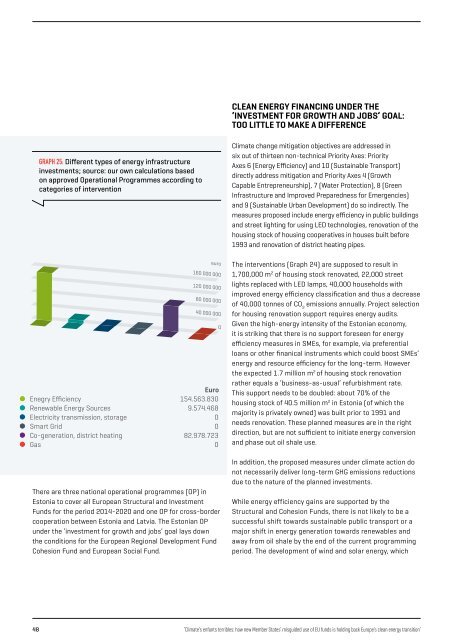ENFANTS TERRIBLES
enfants-terribles
enfants-terribles
You also want an ePaper? Increase the reach of your titles
YUMPU automatically turns print PDFs into web optimized ePapers that Google loves.
CLEAN ENERGY FINANCING UNDER THE<br />
‘INVESTMENT FOR GROWTH AND JOBS’ GOAL:<br />
TOO LITTLE TO MAKE A DIFFERENCE<br />
GRAPH 25: Different types of energy infrastructure<br />
investments; source: our own calculations based<br />
on approved Operational Programmes according to<br />
categories of intervention<br />
euro<br />
160 000 000<br />
120 000 000<br />
80 000 000<br />
40 000 000<br />
Euro<br />
Enegry Efficiency 154.563.830<br />
Renewable Energy Sources 9.574.468<br />
Electricity transmission, storage 0<br />
Smart Grid 0<br />
Co-generation, district heating 82.978.723<br />
Gas 0<br />
There are three national operational programmes (OP) in<br />
Estonia to cover all European Structural and Investment<br />
Funds for the period 2014-2020 and one OP for cross-border<br />
cooperation between Estonia and Latvia. The Estonian OP<br />
under the ‘investment for growth and jobs’ goal lays down<br />
the conditions for the European Regional Development Fund<br />
Cohesion Fund and European Social Fund.<br />
0<br />
Climate change mitigation objectives are addressed in<br />
six out of thirteen non-technical Priority Axes: Priority<br />
Axes 6 (Energy Efficiency) and 10 (Sustainable Transport)<br />
directly address mitigation and Priority Axes 4 (Growth<br />
Capable Entrepreneurship), 7 (Water Protection), 8 (Green<br />
Infrastructure and Improved Preparedness for Emergencies)<br />
and 9 (Sustainable Urban Development) do so indirectly. The<br />
measures proposed include energy efficiency in public buildings<br />
and street lighting for using LED technologies, renovation of the<br />
housing stock of housing cooperatives in houses built before<br />
1993 and renovation of district heating pipes.<br />
The interventions (Graph 24) are supposed to result in<br />
1,700,000 m 2 of housing stock renovated, 22,000 street<br />
lights replaced with LED lamps, 40,000 households with<br />
improved energy efficiency classification and thus a decrease<br />
of 40,000 tonnes of CO 2<br />
emissions annually. Project selection<br />
for housing renovation support requires energy audits.<br />
Given the high-energy intensity of the Estonian economy,<br />
it is striking that there is no support foreseen for energy<br />
efficiency measures in SMEs, for example, via preferential<br />
loans or other finanical instruments which could boost SMEs’<br />
energy and resource efficiency for the long-term. However<br />
the expected 1.7 million m 2 of housing stock renovation<br />
rather equals a ‘business-as-usual’ refurbishment rate.<br />
This support needs to be doubled: about 70% of the<br />
housing stock of 40.5 million m 2 in Estonia (of which the<br />
majority is privately owned) was built prior to 1991 and<br />
needs renovation. These planned measures are in the right<br />
direction, but are not sufficient to initiate energy conversion<br />
and phase out oil shale use.<br />
In addition, the proposed measures under climate action do<br />
not necessarily deliver long-term GHG emissions reductions<br />
due to the nature of the planned investments.<br />
While energy efficiency gains are supported by the<br />
Structural and Cohesion Funds, there is not likely to be a<br />
successful shift towards sustainable public transport or a<br />
major shift in energy generation towards renewables and<br />
away from oil shale by the end of the current programming<br />
period. The development of wind and solar energy, which<br />
48<br />
‘Climate’s enfants terribles: how new Member States’ misguided use of EU funds is holding back Europe’s clean energy transition’


